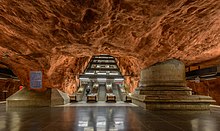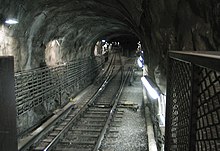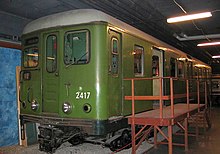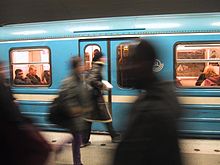
Roslagsbanan is a narrow gauge commuter railway system in Roslagen, Stockholm County, Sweden. Its combined route length is 65 kilometres and there are 38 stations. It is built to the Swedish three foot gauge. The Storstockholms Lokaltrafik (SL) classifies it as "light rail" in its maps.

The SL C5, colloquially the Silver Arrow, was a type of subway train used in the Stockholm metro, Sweden. It was a prototype train produced in one example of 8 cars and was never painted, instead keeping its aluminium "silver" finish. It was rare in trafic and often ran during the night, giving it a mystic appearance, resulting in several urban legends alleging sightings of a silver colored ghost train, simply known as the Silver train, but also "the Silver Arrow".

Tvärbanan is a light-rail line in Stockholm, Sweden. Its name translates literally to The transverse line, as it operates crosswise to the otherwise radial metro and commuter rail lines of Stockholm. It links together several transit lines through its connections with the southern, western and northern subway branches of the Stockholm Metro (Tunnelbana) as well as three branches of the Stockholm commuter rail (Pendeltåg). The possibility to travel between southern, western and northern greater Stockholm without having to enter the city centre significantly reduces the number of transit passengers, also reducing the number of trains having to pass through the Old Town bottleneck during peak hours. Near Liljeholmen the track is shared with freight traffic for a short section, this being the only place in Sweden where freight traffic and trams share the same track.
Stockholm commuter rail is the commuter rail system in Stockholm County, Sweden. The system is an important part of the public transport in Stockholm, and is controlled by Storstockholms Lokaltrafik. The tracks are state-owned and administered by the Swedish Transport Administration, while the operation of the Stockholm commuter rail services itself has been contracted to MTR Nordic since December 2016.

Saltsjöbanan is an electrified suburban rail system between Stockholm and Saltsjöbaden in Nacka, Sweden. It is 18.5 kilometres (11.5 mi) in length and has eighteen stations in use. An average of 17,200 boardings are made on an ordinary workday (2019). The line is mostly single-track, and is isolated from Sweden's national railway network, although both are built to compatible 1,435 mmstandard gauge. The Storstockholms Lokaltrafik (SL) classifies it as "light rail" in its maps.

Transport in Stockholm consists of roads, buses, metro, commuter rail, Inter-city rail, regional rail, light rail, tram, commuter ferry and an archipelago boat operation in Stockholm County, Sweden. The bus and rail is organized by Storstockholms Lokaltrafik, SL, which is owned by the Stockholm County Council. Tickets for all SL services can be purchased most easily in the SL app. For single tickets, just tap a credit card against the turnstiles and on buses. A single ticket is valid for 75 minutes, costs 39 SEK in 2023. The operation and maintenance of the public transport systems are delegated by SL to several contractors. The archipelago boat traffic is handled by Waxholmsbolaget.

T-Centralen is a metro station that forms the heart of the Stockholm metro system, in the sense that it is the only station where all three of the system's lines meet. That, its central location, and its connections with other modes of transport make it the busiest station in the system. The station is located in the Norrmalm borough of Stockholm, between Sergels torg and the street of Vasagatan.

Djurgårdslinjen is a heritage tram line with the route number 7N, running between Norrmalmstorg and Waldemarsudde in Stockholm, Sweden.

Gamla stan is a station on the Green and Red lines of the Stockholm metro. It is located on the western side of the Gamla stan district of central Stockholm, and is at ground level, although partly under the Centralbron bridge that carries road and mainline rail across the waterways that define the centre of the city. The same waterways are responsible for the ground level location of the station, unusual for a city centre metro station, as the lines cross between the islands of Stadsholmen and Södermalm by a bridge immediately south of the station.

Slussen is a station of the Stockholm metro, located in Slussenområdet in the district of Södermalm. The station is served by the Red and Green lines. Originally opened in 1933 as an underground tram stop, on 1 October 1950 it became the terminal of the first metro line running south to Hökarängen, it was again rebuilt when the extension of the line north to Hötorget was opened on 24 November 1957. On 5 April 1964, the first stretch of the Red line, between T-Centralen and Fruängen, was opened.

Fridhemsplan metro station is a station of the Stockholm metro, located in the district of Kungsholmen. The station is entirely underground and provides an interchange between the Blue and Green lines. There are two platforms for each line, about a hundred metres apart.

Enskede gård metro station is on the Green line of the Stockholm metro, located in Enskede gård, Söderort. The station was inaugurated on 1 October 1930 as part of the stretch between Gullmarsplan and Stureby. The distance to Slussen is 3.8 km.

Gullmarsplan metro station is a station on the Green line of the Stockholm metro and the Tvärbanan light rail line, located by Gullmarsplan in Johanneshov, Söderort. The station was opened for trams in 1946 after the construction of Skanstullsbron, and converted to Metro usage on 1 October 1950. On 9 September 1951, an extension south to Stureby was opened. The distance from Slussen is 2.3 km (1.4 mi).

Globen metro station is on the Green line of the Stockholm metro and the Tvärbanan light rail line, located by Globen in Johanneshov, Söderort. The station was opened on 1 October 1930 as Slakthuset station as a part of the stretch between Gullmarsplan and Stureby. In 1958 the station was renamed as Isstadion station. The station acquired its current name on 20 August 1989 and is the only one in the system to have had more than two names. The distance to Slussen is 3 km (1.9 mi). There is a track connection to Tvärbanan just north of Globen metro station, and Tvärbanan has track connection to the railway, which is used for deliveries of new metro trains.

The SL C20 is a type of subway train used in the Stockholm metro, Sweden. Between 1997 and 2004, 271 3-car sets, numbered 2000–2270, were delivered to Stockholm by the former Kalmar Verkstad, owned by Adtranz, later acquired by Bombardier Transportation. The C20 is a completely new design and therefore is not compatible with other train types in the system. At 46.5 metres, each carriage is longer than the previous train types. To save cost and weight, each unit has only four bogies. The middle car has two bogies. The end parts consist of one bogie each and are connected to the central portion via a semi-trailer-direction. Trolley subframes are made of stainless steel, and are less susceptible to corrosion.

The Red line, is one of the three Stockholm Metro lines. It has a total of 36 stations, of which four are cut and cover, 16 are tunneled, and 15 are on the surface. The line is a total of 41.238 kilometres (25.624 mi) long. It consists of four branches with terminals in Fruängen and Norsborg in the southwest and Mörby center and Ropsten in the northeast.

The Blue line is one of the three Stockholm Metro lines. It is 25.5 kilometres long, and runs from Kungsträdgården via T-Centralen to Västra skogen where it branches in two, and continues to Hjulsta and Akalla as lines 10 and 11 respectively.

The SL C30 is a type of subway train used in the Stockholm metro, Sweden. The first set of C30 carriages was inaugurated in 2020 on the Red line, and subsequently replaced all the older rolling stock dating back to the 1970s and 1980s. Since then, 116 sets were delivered to Stockholm by Bombardier Transportation and subsequently by Alstom. A set consists of four carriages which are attached by gangways, in contrast to most previously delivered trains which consist of individual carriages, and which can be connected to other carriages.

The Green Line is the oldest of the three Stockholm Metro lines. The 41.256-kilometre (25.635 mi) long line comprises a single double-tracked line north of the city centre, splitting into three branches south of the city centre. The first section of the line opened as a metro in 1950, making it the first and oldest metro line in the Nordic countries, although some parts of the line date back to the 1930s and were originally used by the Stockholm tramway.

The Silver Train of Stockholm, also known as the the Silver Arrow, is an urban legend about a silver colored ghost train that traffics the Stockholm Metro. The legend is one of several surrounding the Stockholm Metro involving ghost phenomena. The modern railway network, which was inaugurated in 1950, has racked up several mythical urban legends over the years, especially of the horror genre, of which the silver train is the most famous.



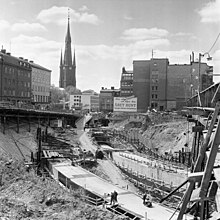
![The 1965 Metropolitan Railway Plan for Stockholm [sv] which follows the current route alignments closely Tunnelbaneplan for Stockholm 1965.jpg](http://upload.wikimedia.org/wikipedia/commons/thumb/7/7f/Tunnelbaneplan_f%C3%B6r_Stockholm_1965.jpg/220px-Tunnelbaneplan_f%C3%B6r_Stockholm_1965.jpg)
